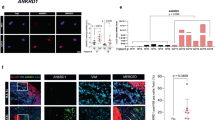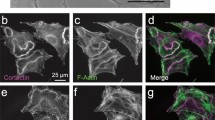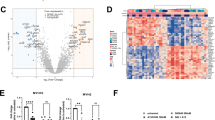Abstract
The nonreceptor protein tyrosine kinase c-Abl regulates cell proliferation and survival. Recent studies provide evidence that implicate c-Abl as a mediator for fibrotic responses induced by transforming growth factor-β (TGF-β), but the precise mechanisms underlying this novel oncogene function are unknown. Here, we report that when expressed in normal fibroblasts, a constitutively active mutant of Abl that causes chronic myelogenous leukemia (CML) stimulated the expression and transcriptional activity of the early growth response factor 1 (Egr-1). Mouse embryonic fibroblasts (MEFs), lacking c-Abl, were resistant to TGF-β stimulation. Responsiveness of these MEFs to TGF-β could be rescued by wild-type c-Abl, but not by a kinase-deficient mutant form of c-Abl. Furthermore, Abl kinase activity was necessary for the induction of Egr-1 by TGF-β in normal fibroblasts, and Egr-1 was required for stimulation of collagen by Bcr-Abl. Lesional skin fibroblasts in mice with bleomycin-induced fibrosis of skin displayed evidence of c-Abl activation in situ, and elevated phospho-c-Abl correlated with increased local expression of Egr-1. Collectively, these results position Egr-1 downstream of c-Abl in the fibrotic response, delineate a novel Egr-1-dependent intracellular signaling mechanism that underlies the involvement of c-Abl in certain TGF-β responses, and identify Egr-1 as a target of inhibition by imatinib. Furthermore, the findings show in situ activation of c-Abl paralleling the upregulated tissue expression of Egr-1 that accompanies fibrosis. Pharmacological targeting of c-Abl and its downstream effector pathways may, therefore, represent a novel therapeutic approach to blocking TGF-β-dependent fibrotic processes.
This is a preview of subscription content, access via your institution
Access options
Subscribe to this journal
Receive 50 print issues and online access
$259.00 per year
only $5.18 per issue
Buy this article
- Purchase on Springer Link
- Instant access to full article PDF
Prices may be subject to local taxes which are calculated during checkout









Similar content being viewed by others
References
Bhattacharyya S, Chen S-J, Wu M, Warner-Blankenship M, Ning H, Lakos G et al. (2008). Smad-independent TGF-β regulation of transcription factor Egr-1 and sustained expression in fibrosis: implications for scleroderma. Am J Path 173: 1085–1099.
Buchwalter G, Gross C, Wasylyk B . (2004). Ets ternary complex transcription factors. Gene 324: 1–14.
Bonner JC . (2004). Regulation of PDGF and its receptors in fibrotic diseases. Cytokine Growth factor Rev 4: 255–273.
Ceni E, Crabb DW, Foschi M, Mello T, Taricchi M, Patussi V et al. (2006). Acetaldehyde inhibits PPAR-g via H2O2-mediated c-Abl activation in human hepatic stellate cells. Gastroenterology 131: 1235–1252.
Che W, Abe J, Yoshizumi M, Huang Q, Glassman M, Ohta S et al. (2001). p160 Bcr mediates platelet-derived growth factor activation of extracellular signal-regulated kinase in vascular smooth muscle cells. Circulation 104: 1399–1406.
Chen SJ, Ning H, Ishida W, Sodin-Semrl S, Takagawa S, Mori Y et al. (2006). The early-immediate gene EGR-1 is induced by transforming growth factor-beta and mediates stimulation of collagen gene expression. J Biol Chem 281: 21183–21197.
Chen SJ, Yuan W, Mori Y, Levenson A, Trojanowska M, Varga J . (1999). Stimulation of Type I collagen transcription in human skin fibroblasts by TGF-β: involvement of Smad 3. J of Invest Dermatol 112: 49–57.
Danial NN, Rothman P . (2000). JAK-STAT signaling activated by Abl oncogenes. Oncogene 19: 2523–2531.
Daniels CE, Wilkes MC, Edens M, Kottom TJ, Murphy SJ, Limper AH et al. (2004). Imatinib mesylate inhibits the profibrogenic activity of TGF-beta and prevents bleomycin-mediated lung fibrosis. J Clin Invest 114: 1308–1316.
Deininger MW, Goldman JM, Lydon N, Melo JV . (1997). The tyrosine kinase inhibitor CGP57148B selectively inhibits the growth of BCR-ABL-positive cells. Blood 90: 3691–3698.
Distler JH, Jüngel A, Huber LC, Schulze-Horsel U, Zwerina J, Gay RE et al. (2007). Imatinib mesylate reduces production of extracellular matrix and prevents development of experimental dermal fibrosis. Arthritis Rheum 56: 311–322.
Druker BJ, Tamura S, Buchdunger E, Ohno S, Segal GM, Fanning S et al. (1996). Effects of a selective inhibitor of the Abl tyrosine kinase on the growth of Bcr-Abl positive cells. Nat Med 2: 561–566.
Gashler A, Sukhatme VP . (1995). Early growth response protein 1 (Egr-1): prototype of a zinc-finger family of transcription factors. Prog Nucleic Acid Res Mol Biol 50: 191–224.
Groffen J, Stephenson JR, Heisterkamp N, de Klein A, Bartram CR, Grosveld G . (1984). Philadelphia chromosomal breakpoints are clustered within a limited region, bcr, on chromosome. Cell 36: 93–99.
Goldman JM, Melo JV . (2003). Chronic myeloid leukemia--advances in biology and new approaches to treatment. N Engl J Med 349: 1451–1464.
Goumans MJ, Valdimarsdottir G, Itoh S, Rosendahl A, Sideras P, ten Dijke P . (2002). Balancing the activation state of the endothelium via two distinct TGF-beta type I receptors. EMBO J 21: 1743–1753.
He X . (2006). Unwinding a Path to Nuclear β-Catenin. Cell 127: 40–42.
Hernández SE, Krishnaswami M, Miller AL, Koleske AJ . (2004). How do Abl family kinases regulate cell shape and movement? Review Trends Cell Biol 14: 36–44.
Ihn H, LeRoy EC, Trojanowska M . (1997). Oncostatin M stimulates transcription of the human α2 (I) collagen gene via the Sp1/Sp3-binding site. J Biol Chem 272: 24666–24672.
Ishida W, Bhattacharyya S, Hinchcliff M, Mori Y, Takehara K, Varga J . (2006). Novel role of c-Abl tyrosine kinase in profibrotic TGF-Beta responses: Selective modulation by the anticancer drug imatinib methylate (gleevec). Arthritis Rheum 54: S776.
Javelaud D, Mauviel A . (2005). Crosstalk mechanisms between the mitogen-activated protein kinase pathways and Smad signaling downstream of TGF-beta: implications for carcinogenesis. Oncogene 24: 5742–5750.
Jimenez SA, Derk CT . (2004). Following the molecular pathways toward an understanding of the pathogenesis of systemic sclerosis. Ann Intern Med 140: 37–45.
Khachigian LM . (2006). Early growth response-1 in cardiovascular pathobiology. Circ Res 98: 186–191.
Kharbanda SP, Pandey S, Jin S, Inoue A, Bharti Z-M, Yuan R et al. (1997). Functional interaction of DNA-PK and c-Abl in response to DNA damage. Nature 386: 732–735.
Kharbanda SP, Pandey R, Ren S, Feller B, Mayer L, Zon et al. (1995a). c-Abl activation regulates induction of the SEK1/stress activated protein kinase pathway in the cellular response to 1-β-D-arabinofuranosylcytosine. J Biol Chem 270: 30278–30281.
Kharbanda SR, Ren P, Pandey TD, Shafman SM, Feller RR, Weichselbaum et al. (1995b). Activation of the c-Abl tyrosine kinase in the stress response to DNA-damaging agents. Nature 376: 785–788.
Kharas MG, Fruman DA . (2005). ABL oncogenes and phosphoinositide 3-kinase: mechanism of activation and downstream effectors. Cancer Res 65: 2047–2053.
Lakos G, Takagawa S, Chen SJ, Ferreira AM, Han G, Masuda K et al. (2004). Targeted disruption of TGF-beta/Smad3 signaling modulates skin fibrosis in a mouse model of scleroderma. Am J Pathol 165: 203–217.
La Rosée P, Johnson K, O’Dwyer ME, Druker BJ . (2002). In vitro studies of the combination of imatinib mesylate (Gleevec) and arsenic trioxide (Trisenox) in chronic myelogenous leukemia. Exp Hematol 30: 729–737.
Lewis JM, Baskaran R, Taagepera S, Schwartz MA, Wang JY . (1996). Integrin regulation of c-Abl tyrosine kinase activity and cytoplasmic-nuclear transport. Proc Natl Acad Sci U S A 93: 15174 –15179.
Lewis JM, Schwartz MA . (1998). Integrins regulate the association and phosphorylation of paxillin by c-Abl. J Biol Chem 273: 14225–14230.
Leask A . (2008). Targeting the TGFβ, endothelin-1 and CCN2 axis to combat fibrosis in scleroderma. Cellular Signalling 20: 1409–1414.
Lugo TG, Pendergast AM, Muller AJ, Witte ON . (1990). Tyrosine kinase activity and transformation potency of bcr-abl oncogene products. Science 247: 1079–1082.
Massagueé J, Seoane J, Wotton D . (2005). Smad transcription factors. Genes Dev 19: 2783–2810.
Mori Y, Chen SJ, Varga J . (2000). Modulation of endogenous Smad expression in normal skin fibroblasts by transforming growth factor-beta. Exp Cell Res 258: 374–383.
Mori Y, Ishida W, Bhattacharyya S, Li Y, Platanias LC, Varga J . (2004). Selective inhibition of activin receptor-like kinase 5 signaling blocks profibrotic transforming growth factor beta responses in skin fibroblasts. Arthritis Rheum 50: 4008–4021.
Moustakas A, Heldin CH: Non-Javelaud D, Mauviel . (2005). A Crosstalk mechanisms between the mitogen-activated protein kinase pathways and Smad signaling downstream of TGF-beta: implications for carcinogenesis. Oncogene 24: 5742–5750.
Pannu J, Asano Y, Nakerakanti S, Smith E, Jablonska S, Blaszczyk M et al. (2008). Smad1 pathway is activated in systemic sclerosis fibroblasts and is targeted by imatinib mesylate. Arthritis Rheum 58: 2528–2537.
Pannu J, Nakerakanti S, Smith E, ten Dijke P, Trojanowska M . (2007). Transforming growth factor-beta receptor type I-dependent fibrogenic gene program is mediated via activation of Smad1 and ERK1/2 pathways. J Biol Chem 282: 10405–10413.
Pannu J, Trojanowska M . (2004). Recent advances in fibroblast signaling and biology in scleroderma. Curr Opin Rheumatology 6: 739–745.
Raitano AB, Halpern JR, Hambuch TM, Sawyers CL . (1995). The Bcr-Abl leukemia oncogene activates Jun kinase and requires Jun for transformation. Proc Natl Acad Sci USA 92: 11746–11755.
Rajkumar VS, Shiwen X, Bostrom M, Leoni P, Muddle J, Ivarsson M et al. (2006). Platelet-derived growth factor-β receptor activation is essential for fibroblast and pericyte recruitment during cutaneous wound healing. Am J Pathol 169: 2254–2265.
Renshawa MW, Lewisa JM, Schwartz MA . (2000). The c-Abl tyrosine kinase contributes to the transient activation of MAP kinase in cells plated on fibronectin. Oncogene 19: 3216–3219.
Rosenbloom J, Jiménez SA . (2008). Molecular ablation of transforming growth factor beta signaling pathways by tyrosine kinase inhibition: the coming of a promising new era in the treatment of tissue fibrosis. Arthritis Rheum 58: 2219–2224.
Rowley JD . (1973). Letter: A new consistent chromosomal abnormality in chronic myelogenous leukaemia identified by quinacrine fluorescence and Giemsa staining. Nature 243: 290–293.
Sánchez-Arévalo Lobo VJ, Aceves Luquero CI, Alvarez-Vallina L, Tipping AJ, Viniegra JG, Hernández Losa J . (2005). Modulation of the p38 MAPK (mitogen-activated protein kinase) pathway through Bcr/Abl: implications in the cellular response to Ara-C. Biochem J 387: 231–238.
Schubert C, Schalk-Hihi C, Struble GT, Ma HC, Petrounia IP, Brandt B et al. (2007). Crystal structure of the tyrosine kinase domain of colony-stimulating factor-1 receptor (cFMS) in complex with two inhibitors. J Biol Chem 282: 4094–4101.
Skorski T, Bellacosa A, Nieborowska-Skorska M, Majewski M, Martinez R, Choi JK et al. (1997). Transformation of hematopoietic cells by BCR/ABL requires activation of a PI-3k/Akt-dependent pathway. EMBO J 16: 6151–6161.
Sukhatme VP, Cao XM, Chang LC, Tsai-Morris CH, Stamenkovich D, Ferreira PC et al. (1988). A zinc finger-encoding gene coregulated with c-fos during growth and differentiation, and after cellular depolarization. Cell 53: 37–43.
Stuart JR, Kawai H, Tsai KK, Chuang EY, Yuan ZM . (2005). c-Abl regulates early growth response protein (EGR1) in response to oxidative stress. Oncogene 24: 8085–8092.
Svaren J, Ehrig T, Abdulkadir SA, Ehrengruber MU, Watson MA, Milbrandt J . (2000). EGR1 target genes in prostate carcinoma cells identified by microarray analysis. J Biol Chem 275: 38524–38531.
Takagawa S, Lakos G, Mori Y, Yamamoto T, Nishioka K, Varga J . (2003). Sustained activation of fibroblast transforming growth factor-beta/Smad signaling in a murine model of scleroderma. J Invest Dermatol 121: 41–50.
Takahashi T, Abe H, Arai H, Matsubara T, Nagai K, Matsuura M et al. (2005). Activation of STAT3/Smad1 is a key signaling pathway for progression to glomerulosclerosis in experimental glomerulonephritis. J Biol Chem 280: 7100–7106.
Teckchandani AM, Feshchenko EA, Tsygankov AY . (2001). c-Abl facilitates fibronectin matrix production by v-Abl-transformed NIH3T3 cells via activation of small GTPases. Oncogene 20: 1739–1755.
Varga J, Abraham D . (2007). Systemic sclerosis: a prototypic multisystem fibrotic disorder. J Clin Invest 117: 557–567.
Varga JA, Trojanowska M . 2008). Fibrosis in systemic sclerosis. Rheum Dis Clin North Am 34: 115–143.
Van Etten RA . (1999). Cycling, stressed-out and nervous: cellular functions of c-Abl. Trends Cell Biol 9: 179–186.
Virolle T, Adamson ED, Baron V, Birle D, Mercola D, Mustelin T et al. (2001). The Egr-1 transcription factor directly activates PTEN during irradiation-induced signaling. Nat Cell Biol 3: 1124–1128.
Wang S, Wilkes MC, Leof EB, Hirschberg R . (2005). Imatinib mesylate blocks a non-Smad TGF-beta pathway and reduces renal fibrogenesis in vivo. FASEB J 19: 1–11.
Wenner CE, Yan S . (2003). Biphasic role of TGF-beta1 in signal transduction and crosstalk. J Cell Physiol 196: 42–50.
Wilkes MC, Leof EB . (2006). Transforming growth factor beta activation of c-Abl is independent of receptor internalization and regulated by phosphatidylinositol 3-kinase and PAK2 in mesenchymal cultures. J Biol Chem 281: 27846–27854.
Woodring PJ, Litwack ED, O’Leary DD, Lucero GR, Wang JY, Hunter T . (2002). Modulation of the Factin cytoskeleton by c-Abl tyrosine kinase in cell spreading and neurite extension. J Cell Biol 156: 879–892.
Yoshida K, Weichselbaum R, Kharbanda S, Kufe D. (2000). Role for Lyn tyrosine kinase as a regulator of stress-activated protein kinase activity in response to DNA damage. Mol Cell Biol 20: 5370–5380.
Acknowledgements
We are grateful to Anthony Koleske (Yale University, New Haven, CT, USA) and Pamela Woodring (The Salk Institute, La Jolla, CA) for Abl-null/Arg-null and Abl reconstituted mouse embryonic fibroblasts, and Leonidas Platanias (Northwestern University Feinberg School of Medicine) for Bcr-Abl plasmids and helpful discussions. This study was supported by grants from the National Institutes of Health (AR-42309) and the Department of Defence (W81-XWH-06-01-0278).
Author information
Authors and Affiliations
Corresponding author
Rights and permissions
About this article
Cite this article
Bhattacharyya, S., Ishida, W., Wu, M. et al. A non-Smad mechanism of fibroblast activation by transforming growth factor-β via c-Abl and Egr-1: selective modulation by imatinib mesylate. Oncogene 28, 1285–1297 (2009). https://doi.org/10.1038/onc.2008.479
Received:
Revised:
Accepted:
Published:
Issue Date:
DOI: https://doi.org/10.1038/onc.2008.479
Keywords
This article is cited by
-
Cereblon contributes to the development of pulmonary fibrosis via inactivation of adenosine monophosphate-activated protein kinase α1
Experimental & Molecular Medicine (2021)
-
Emerging targets of disease-modifying therapy for systemic sclerosis
Nature Reviews Rheumatology (2019)
-
Interstitial Lung Disease in Systemic Sclerosis: Lessons Learned from Idiopathic Pulmonary Fibrosis
Current Treatment Options in Rheumatology (2019)
-
Inhibition of integrin αVβ6 changes fibril thickness of stromal collagen in experimental carcinomas
Cell Communication and Signaling (2018)
-
Cytokines in the immunopathology of systemic sclerosis
Seminars in Immunopathology (2015)



